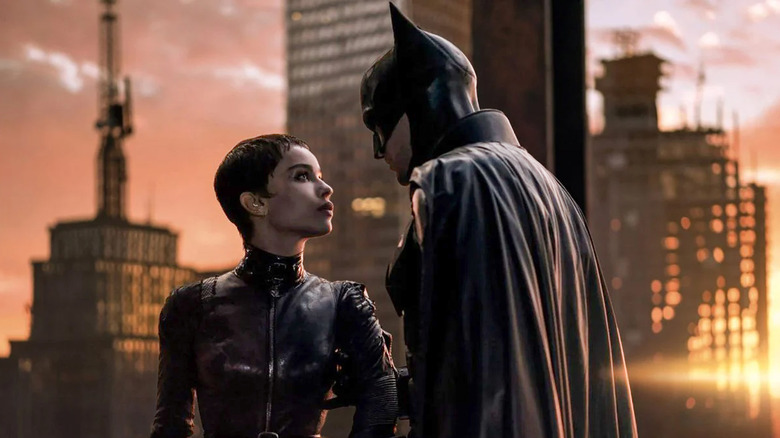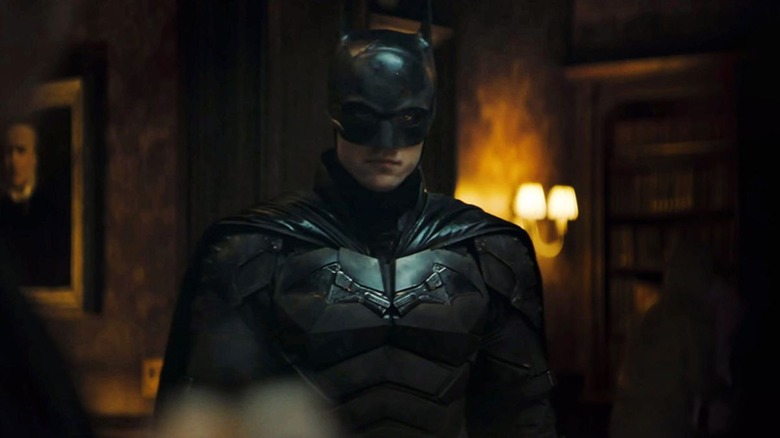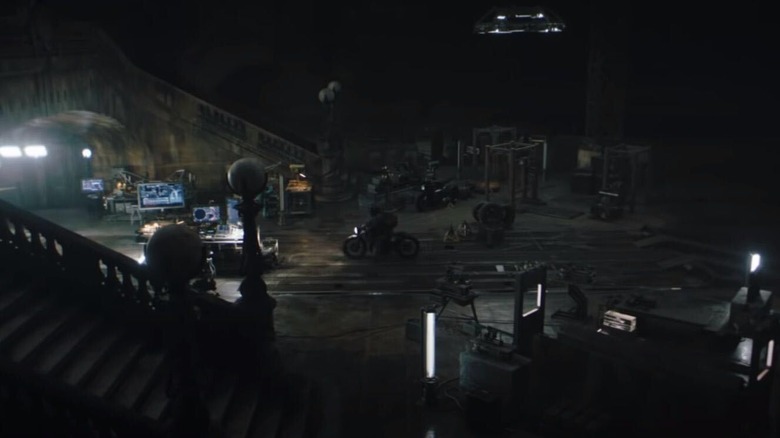Why The Batman Put Bruce Wayne In A Tower Instead Of A Manor
We may receive a commission on purchases made from links.
Batman's origin story has been retold in countless ways over the years. By this point, the general population has absorbed the details by osmosis. Bruce Wayne was orphaned when his parents were murdered in Gotham City. Under the care of their butler Alfred, he lives in Wayne Manor and eventually becomes a broody vigilante with some of the coolest gadgets in the game. And many of those toys are developed by Wayne Industries, which is housed in Wayne Tower.
However, when it came to building the world of "The Batman," filmmaker Matt Reeves and his team decided to switch things up a little. Rather than having Bruce live outside of the city that he keeps a watchful eye over whenever he puts on the cape and the cowl, they decided that their Dark Knight should live in Wayne Tower. In an interview with Variety, production designer James Chinlund gave some insight as to why they made this change to young Master Wayne's living arrangements.
"A lot of the previous Gothams have had Bruce situated in a mansion in the suburbs. He comes in to fight crime and goes back to the suburbs. Bruce is of the city, a part of the fabric [...] That made perfect sense as a center for operations for Bruce and it allowed us to explore all the beautiful decay and patina which set the tone for the rest of the film."
Now, thanks to the recently released hardcover book "The Art of The Batman," we have even more insight into the place where Robert Pattinson's Caped Crusader lays his head at night. Or where he would lay his head at night if he weren't patrolling the city in the name of justice.
Where are your manors?
In the official behind-the scenes illustrated tie-in book by James Field, the author spoke to both Reeves and Chinlund about the decision to go with Bruce living in Wayne Tower versus the more common Wayne Manor. First, the director shares that they were inspired by the urban dwellings of wealthy families like the Rockefellers or the Vanderbilts and the recognizable skyscrapers of major cities when designing their tower. Then they just sprinkled in some of Bruce's trademark angst to complete their recipe.
"Wayne Tower, in the movies, is usually the business hub of Wayne Enterprises, but we wanted to take this gothic tower and turn it into Bruce's home. It would be an old skyscraper, long past its glory days like you might see at the base of Central Park or some grand old building in Chicago. A place the Rockefellers or Vanderbilts could have lived in.
For me, one of the main references for the tower was the Maysles brothers' documentary Grey Gardens, about a reclusive mother and daughter living alone in an old derelict New York mansion. The idea of getting the decay to show through so that you can see what once was but is no longer-and that sense of the beauty of decay, and how that was reflective of Bruce, of his character was key. He doesn't care about any of the traditional family history anymore. He's so into his obsessive mission, it's like a drug for him, he's addicted to being Batman. So when you look closely at the inside of Wayne Manor, it looks like somebody has just let everything fall apart."
Back on track
Production designer Chinlund really puts it into perspective when he mentions that it doesn't make sense for Bruce to commute into the city whenever crime breaks out. No matter how fast his Batmobile or Batplane is, logic says that there's definitely that chance that Batman could miss something due to his commute. So when it came to adapting the Batcave to be a more city-friendly dwelling, he revealed that they found inspiration in one of the most recognizable hotels in New York City.
"If the Wayne [family] built this tower in the twenties, what would be below this tower that would offer an opportunity for a cave? There's an underground train station at the Waldorf Astoria in New York. The myth is that there's a train parked there all the time, and the idea is that whenever the president is in town, if there's ever an emergency and he has to get out of town, they could take him through this secret tunnel at the Waldorf and get him out of town discreetly. I always loved that idea and thought it was so romantic, so I thought about the idea that if you were the Waynes and you had created this city, you would probably have your own secret train terminal under the tower."
All of this makes perfect sense. Not only does it logically put Batman in the center of all the action in Gotham City, but it also opens the possibility that Bruce could have a Battrain at the ready if he wanted. It's probably not the ideal mode of transportation for him, but it's still fun to imagine. Especially if Batman had a conductor's hat to wear over his cowl. If Reeves, Chinlund, and the rest of the gang could just consider that for the sequel or the upcoming HBO Max series set in the world of this movie, I would greatly appreciate it.


